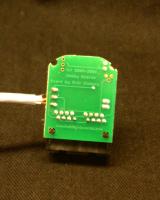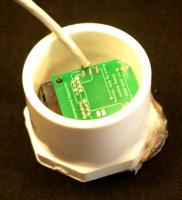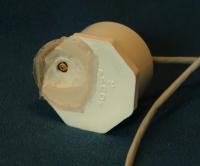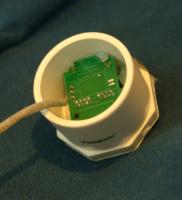
|
Hobby Boards sells a Solar
Radiation Detector, but the case
that they sell does not provide substantial protection from humid or outdoor
environments, and I wanted to mount my sensor outdoors (and get a good
reading on the level of sunlight). So, I built my own enclosure out of PVC
pipe.
The first thing I had to do was reduce the size of the board a little, by
grinding down the corners (carefully avoiding the PC board traces!) As you
can see, after trimming, the board just fits into a 2" PVC end-cap. There
is no room to use the RJ45 connectors, so I hard-wired the Cat-5 into the
screw terminals.
The next task was preparing the other end of the 2" cap. Using a Dremel, I
drilled a hole large enough to allow the sensor to peer out of the cap.
However, the end of the cap is about 3/8"" thick, and the sensor was
sitting at the bottom of a deep hole (which would tell me when the sun was
overhead, but would not give good light measurements any other time).
So
using the Dremel, I carved out a conical section approximately 1" in diameter
and about 3/8" deep (so very roughly, an oblique 30° cone). Since the
cone would funnel rainwater directly onto the sensor, I sacrificed an old
daylight filter from my 35mm camera and glued in over the aperture with silicone cement. This
provides a waterproof but optically very clear surface for which the sensor
to look at the sky, and allows that even the low-slanting light of winter
mornings will reach the sensor.
Finally, because the sensor will be mounted pointing skyward (and the
board might therefore fall out of its place in the cap), I applied a dab of
silicone cement to each corner of the board. It is non-conductive, and will
keep the board and sensor in place.
|

|
|---|




 So how then, could I make a sensor that was submersible? We wanted to
measure water temperatures at a summer lake house on
Lake George, NY.
The sensor needed to be fully submersible, and in fact needed to sit at the
bottom of the lake, which at this location o about 15' (or 5m) deep.
The first thing I did was to take a nibbler to a Radio Shack multipurpose
PC board. I needed a tiny PC board with room to attach a DS1820, a 10pf
tantalum capacitor (to reduce line noise) and the Cat-5 wires. So I nibbled
out 3 rows of three adjacent conductors, and soldered in the pieces.
I applied a dab of thermal grease to the end of the DS1820 (to ensure
accurate measurements), and slid the
board into a blood-draw test tube (the kind with a rubber stopper that they
take blood samples with). Before doing this, I punched a hole into the
stopper, and threaded the wire through, and put a healthy dollop of
MarineGoop
on the inside and outside of the stopper (where the wire passed through), and
then gooped the inside of the tube and pressed the stopper in place. After
the first coat of goop dried, I applied a liberal amount of goop over the
whole stopper, so that it completely covered the stopper and bridged over the
glass.
Next, I connected the wires as shown with tie-wraps, gooped them to the glass,
and connected a 3oz fishing weight. There are a couple of important things to
note about the completed sensor (which survived for 2 years at the bottom of
the lake, and performed flawlessly until we decommissioned it):
So how then, could I make a sensor that was submersible? We wanted to
measure water temperatures at a summer lake house on
Lake George, NY.
The sensor needed to be fully submersible, and in fact needed to sit at the
bottom of the lake, which at this location o about 15' (or 5m) deep.
The first thing I did was to take a nibbler to a Radio Shack multipurpose
PC board. I needed a tiny PC board with room to attach a DS1820, a 10pf
tantalum capacitor (to reduce line noise) and the Cat-5 wires. So I nibbled
out 3 rows of three adjacent conductors, and soldered in the pieces.
I applied a dab of thermal grease to the end of the DS1820 (to ensure
accurate measurements), and slid the
board into a blood-draw test tube (the kind with a rubber stopper that they
take blood samples with). Before doing this, I punched a hole into the
stopper, and threaded the wire through, and put a healthy dollop of
MarineGoop
on the inside and outside of the stopper (where the wire passed through), and
then gooped the inside of the tube and pressed the stopper in place. After
the first coat of goop dried, I applied a liberal amount of goop over the
whole stopper, so that it completely covered the stopper and bridged over the
glass.
Next, I connected the wires as shown with tie-wraps, gooped them to the glass,
and connected a 3oz fishing weight. There are a couple of important things to
note about the completed sensor (which survived for 2 years at the bottom of
the lake, and performed flawlessly until we decommissioned it):



